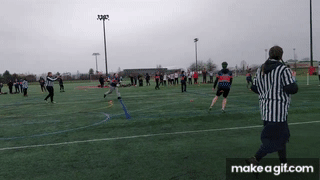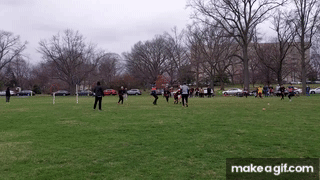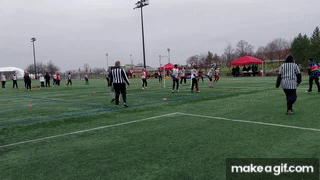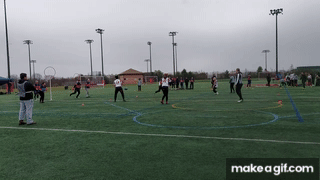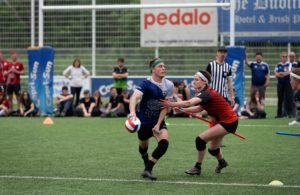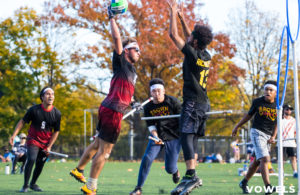- Rule, Britannia, no more?
- Unpopular Opinions: US Quadball Cup 2023
- Proven Contenders: University of Virginia
- Proven Contenders: Rutgers University
- Proven Contenders: University of Michigan
- Proven Contenders: Creighton University
- Different Perspectives: A Look Inside USA Ultimate
- Antwerp QC, Much of Belgian Core, Leaves Competitive Quidditch
Proven Contenders: University of Virginia
- By Ethan Sturm
- Updated: April 13, 2023
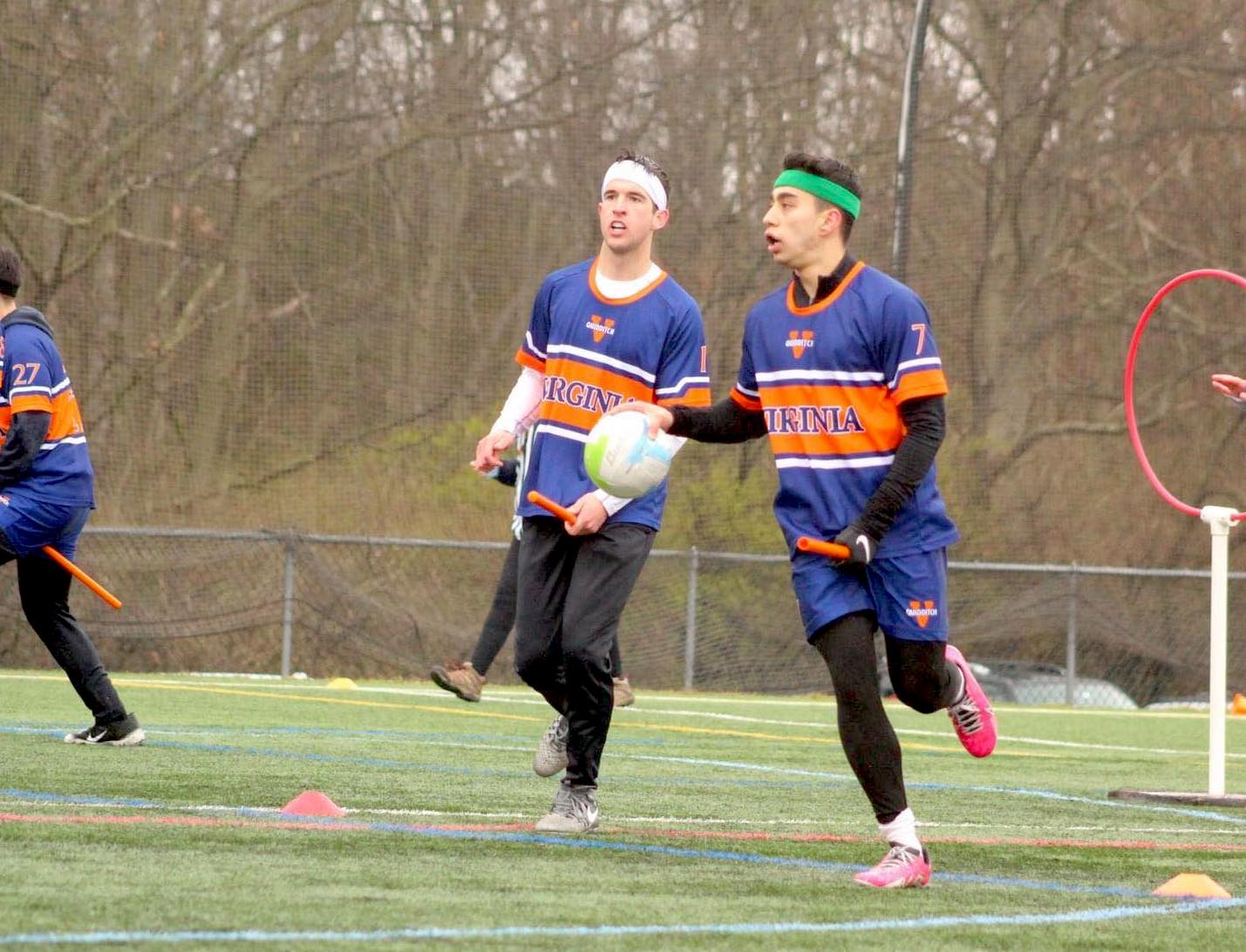
Photo by Zach Armantrading
No. 2 University of Virginia
Record: 18-1
Vs. Top 10: 3-1
Defensive Sets: 1-2-1 Zone
Strengths: Passing Offense, Defensive Pressure
Weaknesses: Not Battle-Tested, Foul Trouble
When I think of the University of Virginia quadball team, I cannot help but to think of the Gonzaga University men’s basketball team in the early days of its dynasty. Back then, every year, all Gonzaga did was blow out every team in its path for the whole regular season, while critics found never-ending ways to discredit the difficulty of their schedule and the credibility of their wins. But they would always show up to the postseason ready to prove themselves, and rarely disappointed in the biggest moments.
The Cavaliers played the quadball equivalent of a “mid-major” schedule this fall, without a single match played against a team that ended the regular season ranked. They traveled to the Mid-Atlantic Regional Championship, where their toughest competition was the University of Florida. Virginia started slow in what ended up being the veritable championship match, but found an offensive flow late in the game and edged out Florida, 135-80.
In the spring semester, Virginia hosted Business Bowl, where they played a pair of matches against No. 3 Rutgers University. The first match was a back-and-forth affair, with Rutgers squeezing it out, 165-140. But in the second, the Cavaliers came out flying, opening up a sizable lead in the opening 10 minutes and holding on for a 190-185 victory.
Virginia ended its regular season at Knights Cup, where it took on a trio of teams from the Massachusetts Quadball Conference, and succinctly crushed every single one, beating No. 8 Harvard University (160-60), followed by No. 10 RPI (200-125) and Brandeis University (145-40). Virginia enters the US Quadball Cup as the only team in the country with one or fewer losses, a noteworthy accomplishment in a parity-filled college field.
There is only one place to start when breaking down this team, and that is with its offense. Virginia runs the only collegiate offense in the country that could be compared favorably to offenses at the highest level of the sport. The offense is pass heavy, and seemingly every player on the field knows their role and where they need to be at all times. Timings are precise, not just within the quadball game, but also between chasers and beaters. Virginia is comfortable using every inch of the offensive zone in its attack and particularly likes to flip opposing defenses by playing from behind the hoops. And the offense is incredibly modular, with different players capable of switching in and out of different roles within the system without missing a beat.
Of course, running an offense at such a high-level requires top-tier personnel, and what the Cavaliers have in their veteran first line is exactly that. If you pull up film of Virginia, Zan Siddiqui and Alex Cruz are the headline makers. The pair are a veritable thunder and lightning, with Cruz being one of the strongest, most difficult to tackle players in the college division, while Siddiqui is one of the fastest and most agile. Be it with speed or with strength, both have gotten into the lane largely at-will all season, providing the incisive movement of which many of the scoring attempts for Virginia are built off.
But focusing only on Cruz and Siddiqui misses the glue that makes this offensive system tick, because most possessions are run through the hands of Andrew Bowman and Emma Rollins. Both players have every necessary pass and shot in their arsenals, and also know when to deploy them. Emma, in particular, has become the full package on offense and one of the best players in the country at her position, whether taking her space and hitting a floater into the middle hoop or timing a cut perfectly off of Cruz or Siddiqui’s driving action for a quick pass-and-catch.
The dynamism of the team’s quadball offense allows the team to put its beaters in positions to succeed, even while the team lacks the same level of star power on that side of the ball. Beaters like Hannah Rollins, Maddie Myott and Drew Reidy all give Virginia solid, mistake-free minutes, but are not often taking over games in the way that a Kyzer Polzin or Jason Ng might at the college level.
To mitigate this, the Cavaliers’ offensive sets are consistently putting its beaters in places to succeed. You will rarely see a possession that begins with Virginia bringing up the ball and making a straight up engage attempt on the opposing beaters. Instead, they use their passing motion to open up attack angles for their beaters, and then look to engage when the defending beaters are no longer on a level playing field.
Take for example this play against Rutgers at Business Bowl. Virginia’s beaters sit patiently on the near side of the offensive set, allowing the chasers to move the ball into the back corner of the pitch. When this action forces the Rutgers free beater off of their hoops with a focus on quaffle, Reidy uses that opportunity to engage, leaving the opposing beater between a rock and a hard place and winning the exchange.
The Cavaliers run a slightly different approach to achieve a very similar outcome in their game against Harvard. Here, the ball once again moves behind the hoops, but this time, Myott is already there in the vicinity of the Harvard free beater. When the passing motion forces the Harvard beater to cover the quadball, Myott takes the opportunity to get a wrap on the opponent, making for an easy beat for Reidy to win back control.
Defensively, Virginia runs one of the more unique sets in the sport, a relic of a prior era in the program that has been modified for the modern game. If you were oversimplifying and drawing it out on a clipboard, you could probably call it a 1-2-1 zone, with a point defender, two defenders at hoops and one floating in the area behind. But in reality, the defense is a high-pressing set that throws waves of pressure at the opposing ball carriers.
Typically, the point defender is looking to meet the opposing team just inside of midfield. If that player is not met with an immediate tap beat, or if they dodge said tap beat, a skill Siddiqui in particular is adept at, they will wreak havoc, making a hit that often forces a weak pass for the team’s beaters to clean up. When the point defender is beat up top, one of the hoop defenders switches in, with the player that started the play behind the hoops stepping up to be a second hoop defender. The final wave of aggression if a team passes through those two interchangeable point defenders is the beaters, who will come flying out on any passing attempt.
This defensive set is not without its flaws. By often giving the first tap beat for free, the defense is instantaneously putting itself at a number disadvantage. And the amount of ground the team’s beaters have to cover can often put them at risk of losing engages. But what the high-pressure does for Virginia is put the ball in the other team’s court. Yes, there are holes to be found, as Harvard does in the below clip. But they require precise timing, passing and chaser-beater coordination from the opposition, something we generally only see in the college game from Virginia itself.
Virginia has employed a variety of flag-on-pitch strategies this season, often choosing to put games away where they have big leads in the quaffle game instead. That said, the team has only caught four flag runners in 19 college matches this season, and none against ranked opposition. When they did go for the flag runner against Rutgers, their beaters struggled and the Scarlet Knights walked away with both catches. And while we know Cruz has been an accomplished seeker in past seasons, he was never playing as many minutes in those seasons in the quaffle game as he does now.
Which brings us to one of the other potential concerns for this Virginia squad: depth. The Cavaliers’ first quadball line plays a lot of minutes. The team also has not had a day all season where they had to play more than two ranked opponents, and even at Knights Cup you could see some of the exhaustion hitting them in their third game of the day. Given the difficulty of the team’s pool–where Harvard, No. 7 University of Texas, UCLA and Columbia College wait for a four-game Saturday–and what a potential bracket run will look like, the team is going to need larger contributions from its second line chasers if it hopes to have a chance to face off with team’s like No. 1 Creighton University and Rutgers late on Sunday.
At the beginning of this article, I compared Virginia to Gonzaga. For 15 years now, Gonzaga has been a force in college basketball, consistently blowing out opponents and making deep championship runs, including earning a spot in two finals matches. But the team has never won the big game. In many ways, that has been Virginia quadball’s lot in life through the years. They spent years playing second fiddle to the University of Maryland in the Mid-Atlantic. They got closer than any team to upsetting the unstoppable Texas squad at US Quadball Cup last year. But the path has never been clearer, nor the team more talented, than it is this year. If Virginia ever wants to kill all of these narratives, the time is now.
Related Posts
About Ethan Sturm
Ethan is the co-founder and former managerial editor and chief correspondent of The Eighth Man. When not talking quidditch, which is rare, he can be found drilling people's teeth and spending time with his elusive wife. He's also the worst.

